
The Holy Trinity Alexander Nevsky Lavra is a male Orthodox monastery in Saint Petersburg.
The monastery is a large complex, which includes: the Holy Trinity Cathedral, several churches and cemeteries (now necropolises), buildings for various purposes, including monastic buildings, as well as a garden, monuments and museums.
The Alexander Nevsky Lavra is the first and largest monastery in St. Petersburg.
The monastery was granted the status of a Lavra in 1797.
Lavra is the name of some of the largest male Orthodox monasteries that have a special historical and spiritual significance.
The Holy Trinity Alexander Nevsky Lavra is located near the historical center of St. Petersburg, at the eastern end of Nevsky Prospekt-just behind Alexander Nevsky Square (the monument to Alexander Nevsky).
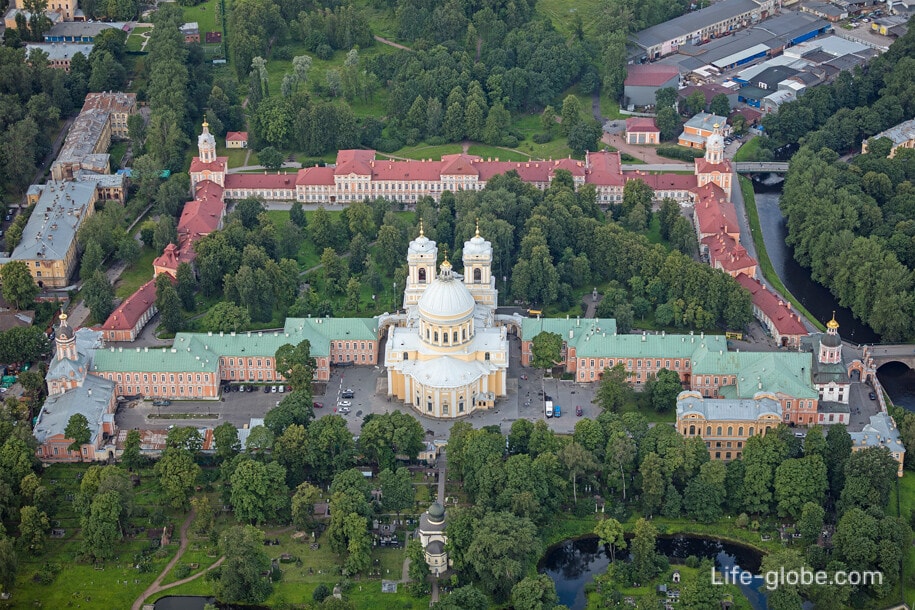
The monastery dates back to the reign of Peter the Great. It was on the initiative of Peter I, from the beginning of 1710, that the monastery was founded. At that time, the monastery was located outside the city, and one of its main goals was to protect and spread the Christian faith and Christian culture. Peter himself conceived of the monastery as a model, as well as a charitable, correctional, educational and medical institution-however, and perhaps fortunately for the monastery (or not), these ideas were never realized.
The construction of the first church of the monastery was probably started in June 1712. The consecration of the first wooden church in the name of the Annunciation of the Blessed Virgin Mary took place on March 25 (April 7, new style), 1713 - on the feast of the Annunciation of the Most Holy Theotokos.
The first and only member of the brotherhood at that time was the abbot of the monastery, "Archimandrite of the newly founded monastery in St. Petersburg" Theodosius (Yanovsky). The monks began to inhabit the monastery when it was already somewhat built up.
The project of the architectural complex of the monastery in stone was designed by the architect Domenico Trezzini. Later, other architects worked on the construction and restoration of the monastery buildings.
Over time, the monastery was completed, redone and expanded. Under him, a school was formed, the main monastery church (the Cathedral of the Holy Trinity) was erected, cemeteries were laid out near it, and the relics of saints, including the relics of the Holy Prince Alexander Nevsky, were transferred to the monastery.
Thus, the monastery grew into a whole vast system of majestic and monumental structures.
After the Decree on the Separation of church and state (1918) was issued, the monastery continued to operate until 1932. After that, the monastery was reorganized and various workshops, organizations and institutions were located on the territory of the Lavra. During the Great Patriotic War-there was a military hospital.
The revival of the monastic monastery began in the fall of 1996. Since then, its restoration and revival of crafts has continued.
The site chosen for the construction of the monastery, and the dedication of the monastery to the holy Prince Alexander Yaroslavich Nevsky had historical significance, and this was explained by the fact that, as it was then believed, on the site of the monastery, the Novgorodians defeated the Swedes in the Battle of the Neva in 1240. However, the famous battle took place higher up the Neva River, where in the 16th century a wooden church was cut down in memory of the victory over the Swedes. However, the legend existed, and perhaps the basis for it was a completely different battle-which took place on May 18, 1301, when the Novgorodians, led by Alexander's son, Prince Andrew, also defeated the Swedes and destroyed the Landskrona fortress built by them in 1300, which stood not far from the places (Okhta Cape) where the Alexander Nevsky Lavra is located.
Despite the above, if we take into account the fact that the monastery was planned to be built during the military operations in the struggle with the Swedes for possession of the mouth of the Neva, and on June 13, 1710, Vyborg was taken, then the historical roll call with the name of the monastery is undeniable.
Today, the Alexander Nevsky Lavra is an active monastery of the St. Petersburg diocese and is a complex, the ensemble of which includes: a cathedral, churches (some of which are working), necropolises, a garden, as well as other buildings and museums.
Entrance to the territory of the complex, to the Holy Trinity Cathedral and churches is free (free of charge). The fee is charged for visiting the hotel museums located on the territory of the Lavra.
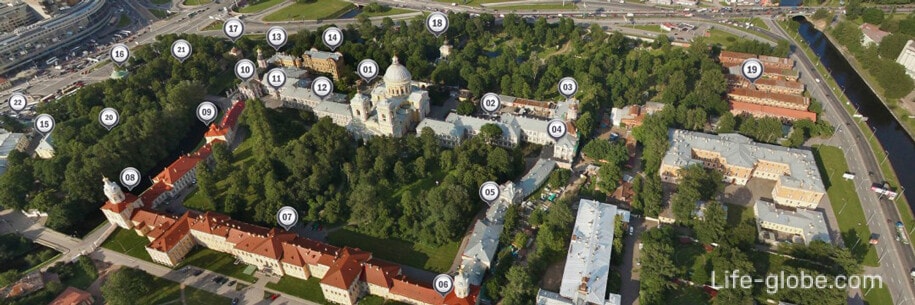
1. Cathedral Church in the name of the Holy Life-giving Trinity (Holy Trinity Cathedral)
2. Fedorovsky Corps (Bratsky)
3. Isidor Church
4. Fedorovskaya Church
5. Southern (Seminary) building
6. South-West Tower (Library)
7. Metropolitan Building
8. North-West Tower (Sacristy)
9. Northern (Prosphorny) building
10. Blagoveshchenskaya - Alexander Nevsky Church
11. Church of the Descent of the Holy Spirit (spiritual and educational center " Svyatodukhovsky»)
12. Dukhovskoy corps (fraternal)
13. The building of the consistory and cemetery office
14. Library building
15. Church of the Tikhvin Icon of the Mother of God
16. The gate Church of the Icon of the Mother of God " Joy to All Who Mourn»
17. The Church of the Righteous Lazarus of the Fourth Day
18. Church of St. Nicholas the Wonderworker (Nikolskoye Cemetery)
19. Complex of buildings of former barns
20. Tikhvin cemetery
21. Lazarevskoye cemetery
22. The building of the former almshouse
Holy Trinity Cathedral is the main cathedral church of the complex, consecrated in the name of the Holy Life-Giving Trinity.
The construction of the cathedral in the last third of the 18th century was one of the most important events in the history of the monastery.
The project of the temple was created by the architect I. E. Starov and approved by the Empress Catherine II in 1776.
The foundation stone of the church was laid on August 30, 1778, on the day of the transfer of the relics of St. Alexander Nevsky. The final construction of the temple was completed by 1790. On August 30 of the same year, the cathedral was solemnly consecrated and the relics of the holy Prince Alexander Nevsky were transferred to it.
In the spring of 1922, most of the church values of the cathedral were requisitioned, including the cancer of the holy Great Prince Alexander Nevsky was opened, the relics were removed, and the silver sarcophagus was transferred to the The Hermitage.
On December 20, 1933, the cathedral was closed, its premises were leased to various organizations, and the paintings were transferred to the Museum Fund. In 1956, a resolution was adopted on the return of the Trinity Cathedral to the faithful. The building of the temple was severely damaged by the actions of the tenants and from the shelling during the Great Patriotic War. In the future, the cathedral was repaired.
In 1989, the relics of St. Alexander Nevsky were returned to the cathedral.
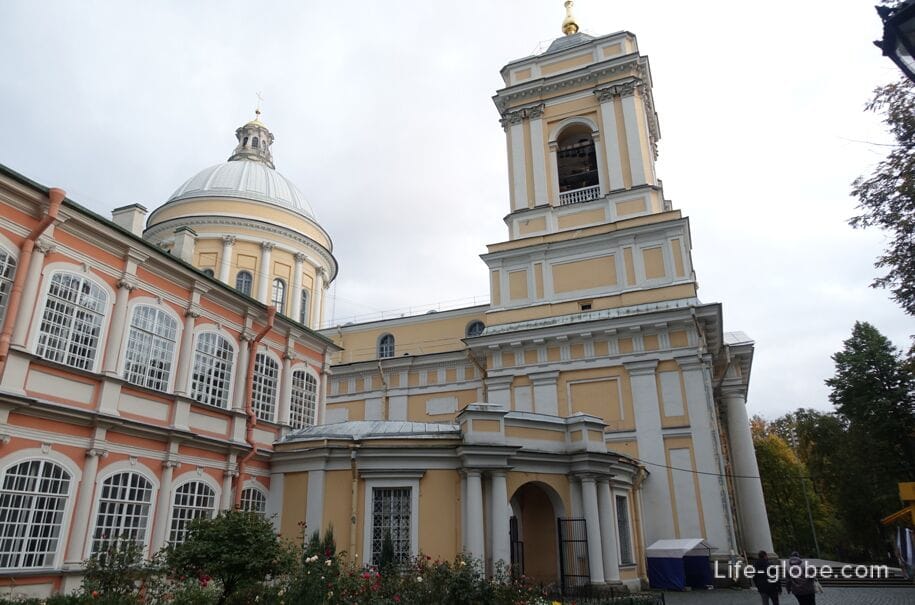
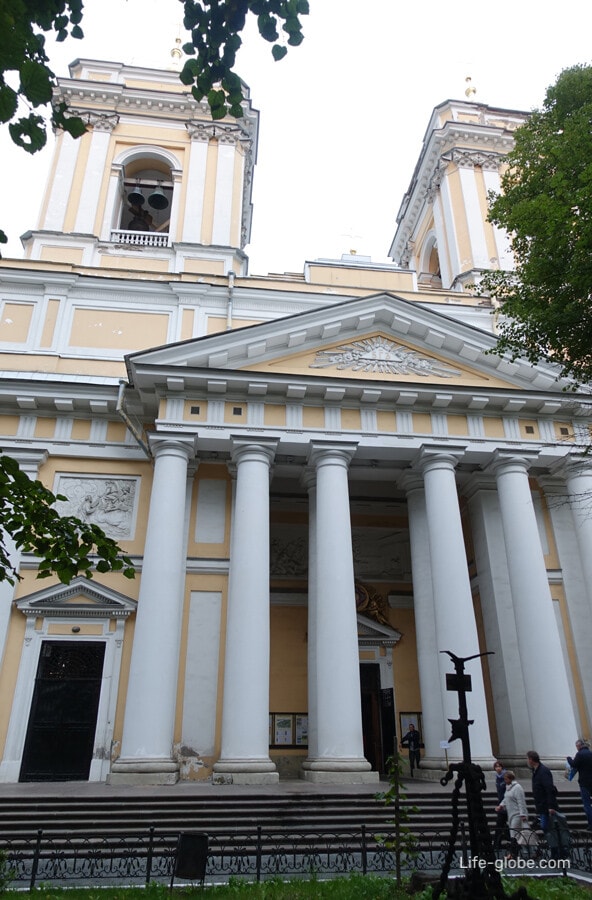
Today, the cathedral is distinguished by its rich interior decoration. Within its walls are many shrines revered by the faithful.

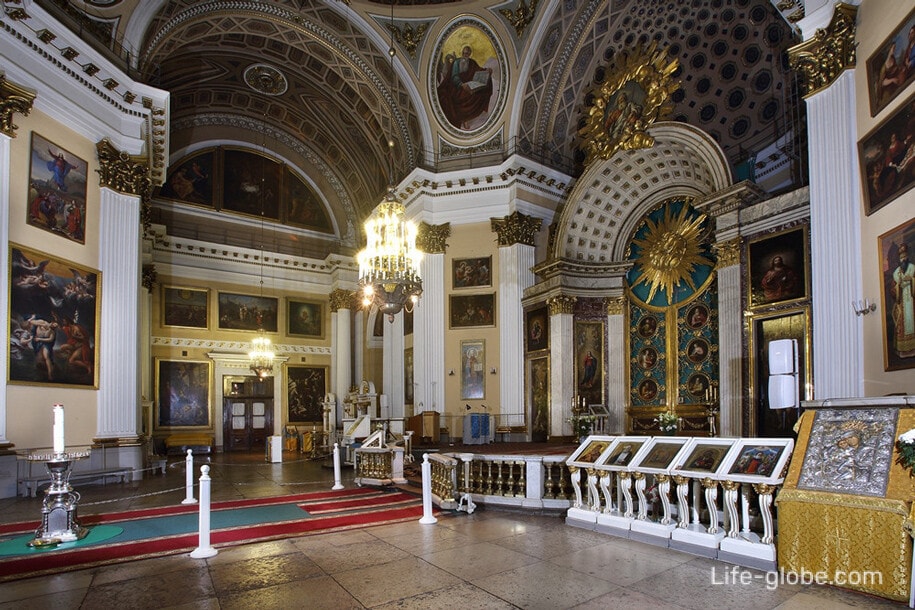
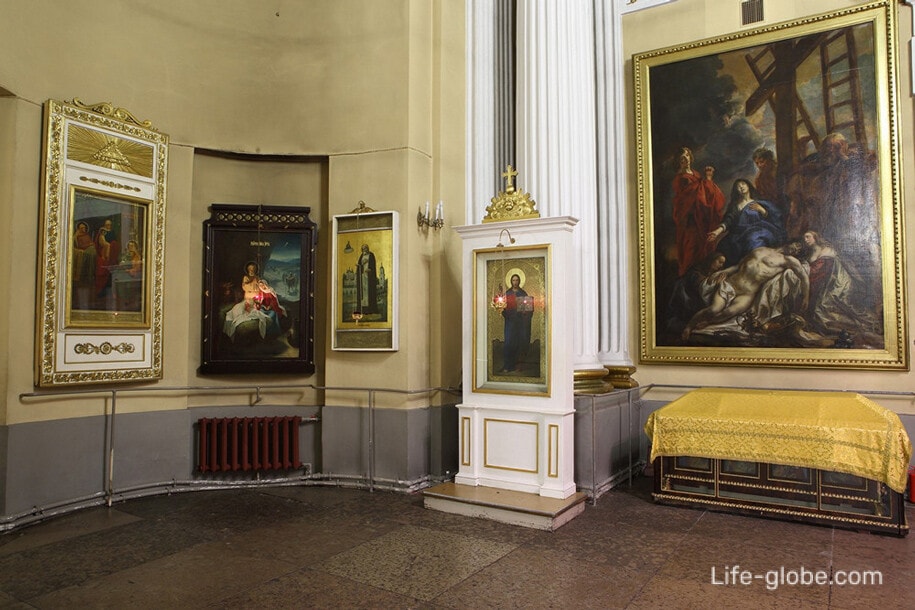
Cossack Cemetery
In front of the Holy Trinity Cathedral is the Cossack Cemetery (until 2009 - "Communist Site").
The first burials at this place began in 1917 - these were the graves of the Cossacks who died during the dispersal of the Bolshevik demonstration in July 1917. Accordingly, the cemetery was called - Cossack.
Since 1918, the cemetery began to bury famous Bolsheviks, scientists and engineers, hereditary St. Petersburg workers, participants in the defense of Petrograd, victims of the Kronstadt mutiny - and since then it has become known as the Communist Site.
Since 1920, the cemetery has been a place of honorary burials. Outstanding doctors, founders of scientific medical schools and professors are buried here: M. I. Astvatsaturov, I. I. Grekov, G. A. Ivashentsov, V. A. Pavlenko, S. P. Fedorov; Major General V. O. Galstyan, Vice Admiral V. P. Drozd, head of construction of the Leningrad Metro I. G. Zubkov, Director of the Hermitage B. V. Legrand and others.
Burials at the cemetery were discontinued in the 1930s and resumed for a time during the Great Patriotic War - participants of the Battle of Leningrad were buried here.
In total, the cemetery contains about 340 graves.
The cemetery is now part of the central part of the Lavra-the main courtyard, and it is crossed by several alleys.
The cemetery is publicly accessible.
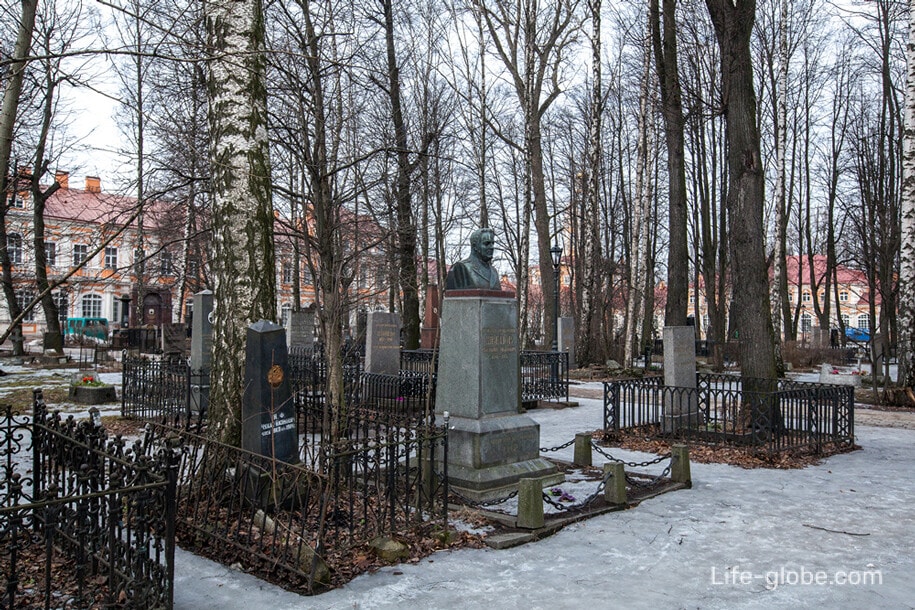
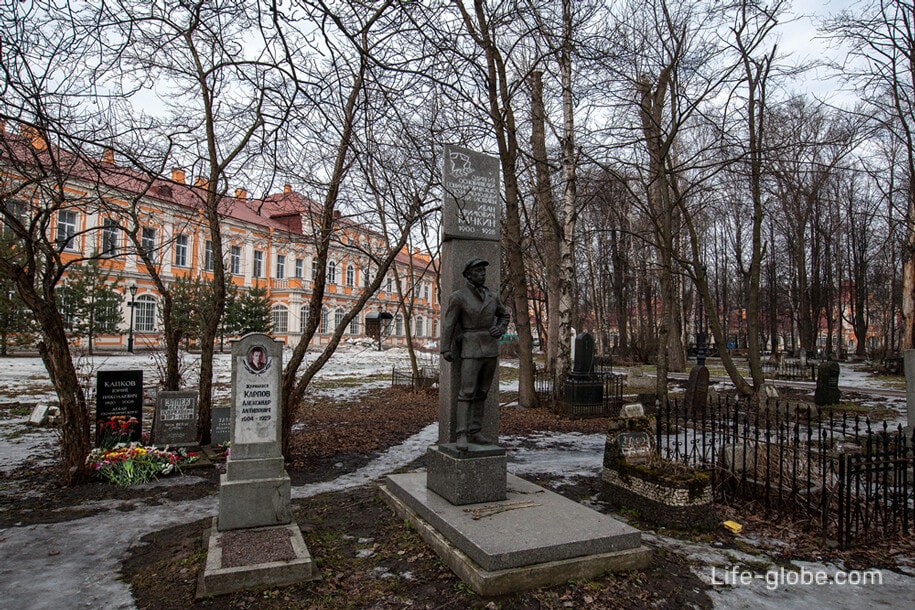
Lavra's Yard
In the center of the monastery complex is a garden surrounded by the cathedral, churches and buildings of the Lavra.
In the courtyard there are alleys, a Cossack cemetery and monuments, including:
- monument "2000th anniversary of the Birth of Christ" by the sculptor Evelina Pavlovna Solovyova.
The monument has a height of almost seven meters. It is installed on a round three-stage base-pedestal, opposite the side entrance to the Holy Trinity Cathedral of the Alexander Nevsky Lavra.
On April 18, 2001, the monument was publicly consecrated by the vicar of the Holy Trinity Alexander Nevsky Lavra, Bishop Nazar of Kronstadt;
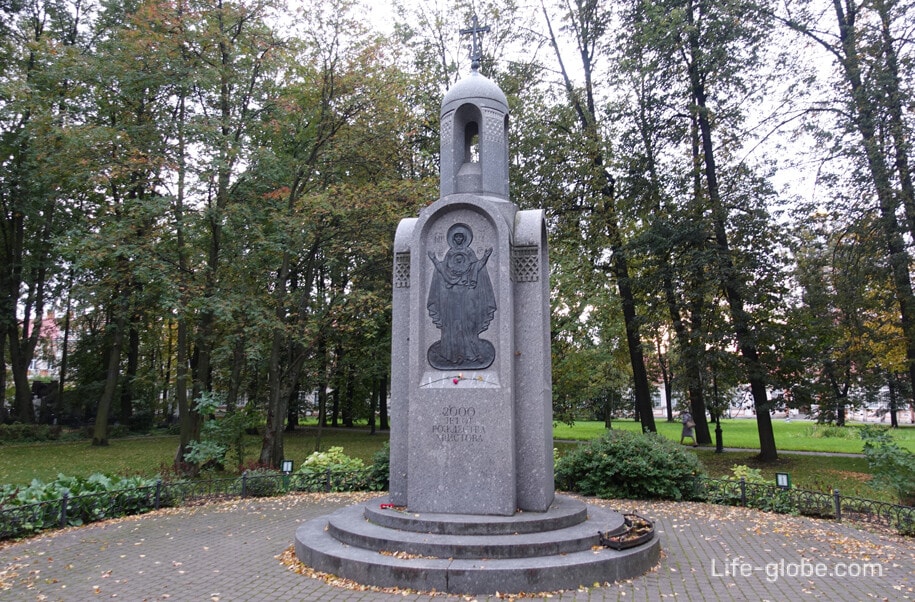
- monument "For the Faith of Christ to the victims" - a monument to all who suffered for the faith of Christ.
The consecration of the monument took place on December 6, 2005, on the memorial day of the Holy Blessed Grand Duke Alexander Nevsky.
The cross in the circle of the monument symbolizes the saved world through the sacrifice of Christ and calls for the deliverance of humanity from the diseases of this age: wars, cruelty, violence and evil. The cross, remaining the core of the composition, includes the iconographic face of the Savior and His words: "But God is not the God of the dead, but of the living. For with Him all are alive."

The Fedorovsky building is the south-eastern building of the monastery, which is adjacent to the Trinity Cathedral on the right, and the construction of which was started by T. Schwertfeger in 1725, and completed in 1748 by P. A. Trezzini.
The south-eastern corner of the monastery square is closed by the two-story St. Nicholas-Theodore Church (the church of the Holy Prince Theodore of Novgorod), built according to the project of Trezzini.
The decoration of the church was completed by 1767. In 1770, the upper church was consecrated in the name of St. Prince Theodore - the brother of Alexander Nevsky, and the lower one in the name of St. John Chrysostom.
In 1840-1842, both churches (upper and lower) were rebuilt and re - consecrated: the upper one-in the name of St. Nicholas the Wonderworker, the lower one - in the name of St. Prince Theodore. From 1806 until the beginning of the 20th century, burials were made in the Feodorovsky Church. The St. Nicholas-Theodore Church served as a tomb for members of the Georgian royal family and bishops.
In the 1930s, the interior of the church was destroyed, most of the tombstones were lost. The building houses a working hostel.
In 1996, the Feodorovskaya Church and the building were returned to the diocese. After the renovation, the inhabitants of the monastery settled in part of the Feodorovsky building, a workshop for artistic metalworking, carpentry and jewelry workshops were opened. From Monday to Friday, daily statutory services are held in the church.
The Fedorovsky (southern) gate of the complex is adjacent to the building.

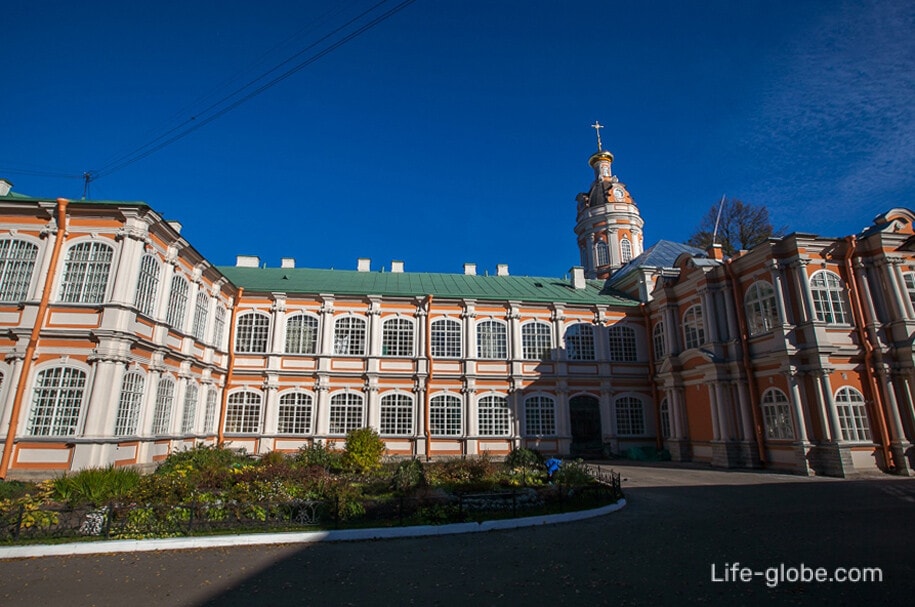
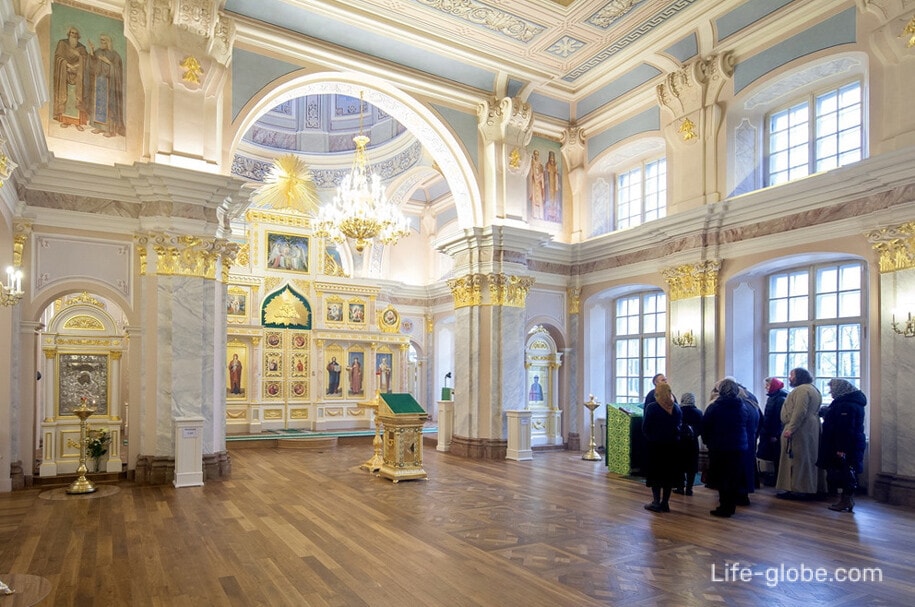
In 2007, a house church was built in the Feodorovsky building in honor of St. Seraphim of Vyritsky.
On weekends, divine services are held in the church, in which the Sunday school of the Alexander Nevsky Lavra participates.

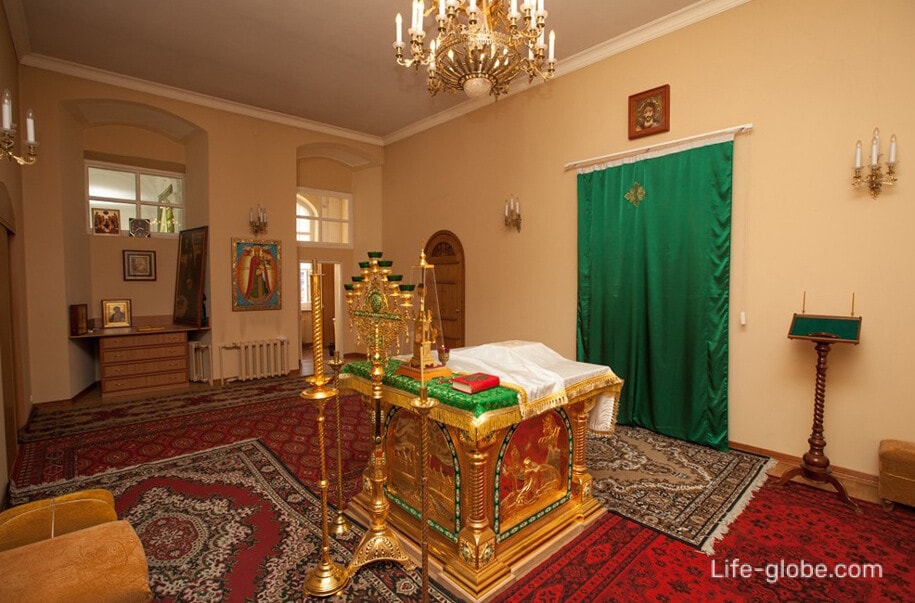
The church-tomb in honor of the Monk Isidore Pelusiot was erected next to the altar part of the Fedorovskaya Church in 1890-1891, designed by the architect G. I. Karpov.
The church was consecrated by Metropolitan Isidore on October 6, 1891, in honor of his heavenly patron, the Venerable Isidore of Pelusiot (Pelusiot). A year later, the Bishop was buried here.
The church served as a tomb for prominent church and state figures, and more than 150 burials were made during the entire railing.
In the 20s, it was closed. The graves were destroyed, the graves looted. Restoration work is underway.
The Metropolitan building is located in the center of the western square on the same axis as the Trinity Cathedral.
The building, together with three other buildings of the monastery, was designed in 1755-1756 by the architect M. D. Rastorguev, who created the project of the monastery "circumference" - buildings that limit the monastery courtyard from the north, west and south, thus closing the square of the monastery courtyard.
In 1756-1764, the Metropolitan, Seminary and Prosphorical buildings with two towers were erected.
The Metropolitan Building was originally a two-story building connected by one-story wings with corner towers.
The south-western and north-western corner towers of the building, erected in 1762-1764, repeated the forms of the Annunciation and Theodore churches. Each of the towers is completed with a high cylindrical drum and a slightly elongated dome, cut by lucarns with a sculptural frame.
Since 1819, extensions and superstructures were built to the Metropolitan House and wings.
The facades of the bishop's chambers are distinguished from other buildings of the Lavra by the richness of architectural design: columns and pilasters in the piers, crepe cornices of the first and second floors and figured window frames give the facade a festive look.
From the interior, the reception hall, which is an example of the ceremonial interior of the mid-18th century, is well preserved. The hall is decorated with Corinthian pilasters and stucco work.

Metropolitan Garden
Behind the Metropolitan House, to the west of the monastery, was a large regular garden with pavilions.
The beginning of work on the creation of the garden dates back to the 1720s. By the end of the 18th century, the garden occupied an area much larger than today; - during the 19th and 20th centuries, due to the growth of the city, the garden area was reduced and is now limited to the bend of the Monastyrka River.
The prosphoric (northern) building of the monastery was created together with the Metropolitan One - in 1756-1764.
From the side of Nevsky Prospekt, the building is bounded by the Monastyrka River.

On the eastern side of the building is the main entrance gate to the courtyard of the monastery - the Annunciation.
On the gate there are icons of the "Saviour Not Made with Hands" and "The Mother of God the Quick-Hearer", made in mosaic.
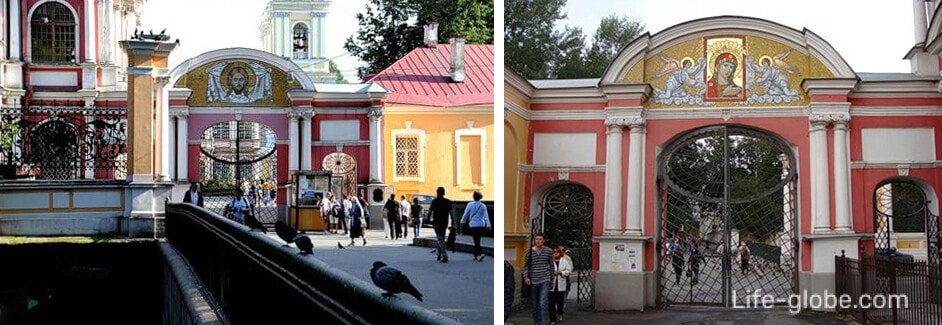
On the wall of the Prosphorical Building, just behind the entrance to the Annunciation Gate (opposite the Church of the Annunciation of the Most Holy Theotokos and the Holy Prince Alexander Nevsky), there is a memorial sign-a relief panel of the Holy Prince Alexander Nevsky.
The memorial sign was opened on the day of the celebration of the 300th anniversary of the Alexander Nevsky Lavra-September 12, 2013.
The sign symbolically unites the historical personality of the holy Prince Alexander Nevsky (patron saint of St. Petersburg) and the history of the origin and construction of the Lavra, as well as the transfer of the relics of the holy prince in 1724 by Peter I from Vladimir to the monastery.
The memorial sign is made of bronze, has dimensions-2100x1100.
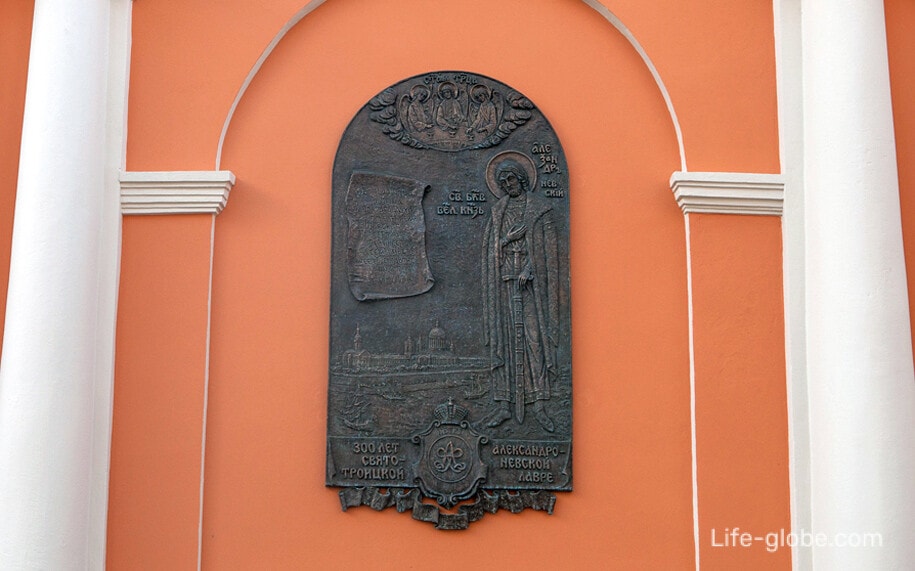
The Church of the Annunciation of the Most Holy Theotokos and the Holy Prince Alexander Nevsky stands in the north-eastern part of the monastery complex, near the Annunciation Gate.
This church is the oldest surviving church in St. Petersburg and one of the most characteristic surviving monuments of St. Petersburg architecture of the early 18th century.
The church was founded in 1717.
The upper church was consecrated on September 12 (August 30), 1724 in honor of the Holy Prince Alexander Nevsky. The lower church was consecrated on April 7 (March 25), 1725, in the name of the Annunciation of the Most Holy Theotokos. Under the lower temple, a tomb was built for 25 places for the burial of members of the royal family and famous nobles. The first burial in the tomb took place on October 24, 1723, when the dowager Tsarina Praskovya Fyodorovna (the widow of Peter I's elder brother, Tsar John V Alekseevich) was buried in the tomb; the remains of Peter I's sister, Tsarevna Natalia Alekseevna, and his son, Tsarevich Peter Petrovich, were also transferred here from the Lazarevskaya Church - tomb.
Later, the church was attached to the "tent" - a vaulted room intended for burials and a small squat gallery-sacristy, which contained the family monuments of the Princes Yusupov.
In 1933, the church was seized from the parish community and transferred to the necropolis Museum-since 1940, the State Museum of Urban Sculpture, in charge of which the church remains to this day. Today, within the walls of the church there is a museum-the Annunciation Tomb (entrance is paid).
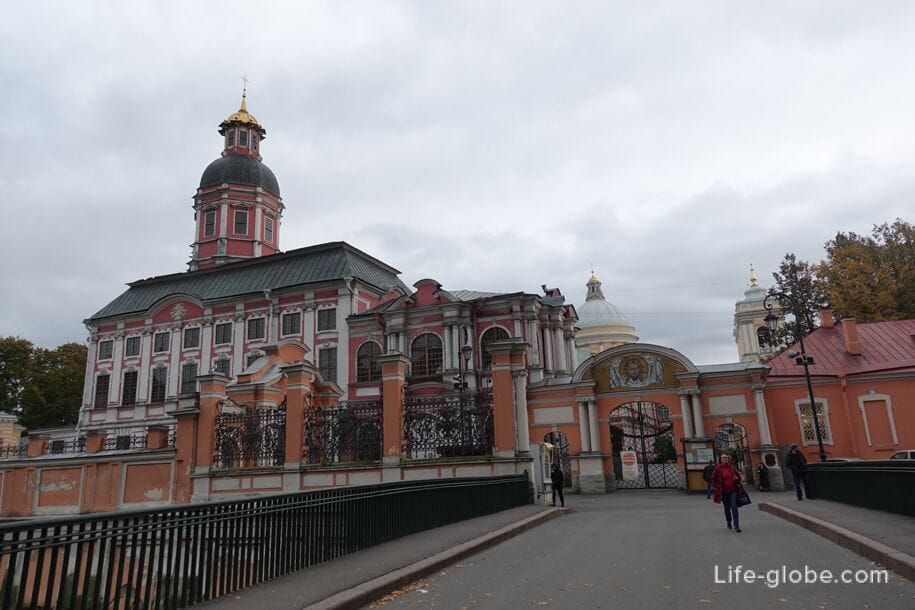
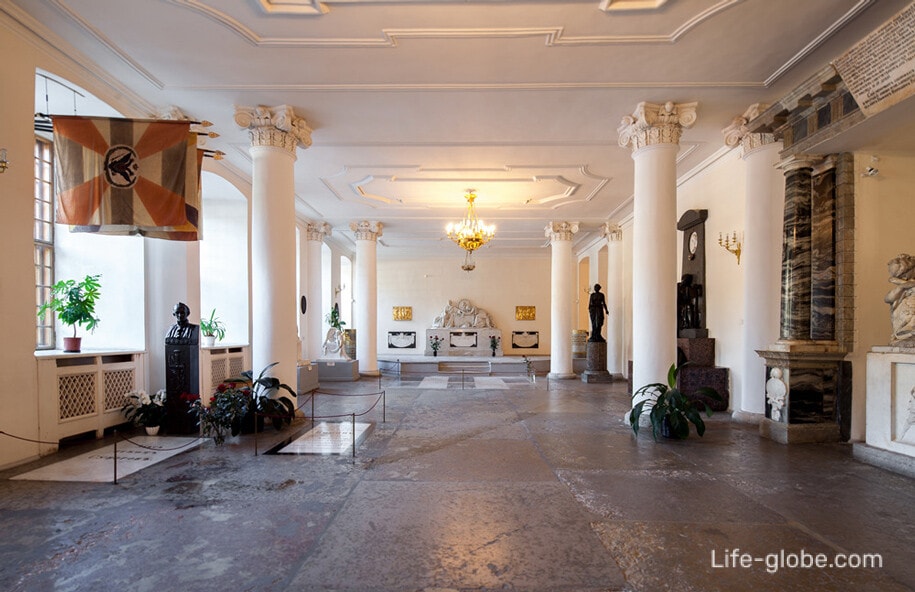
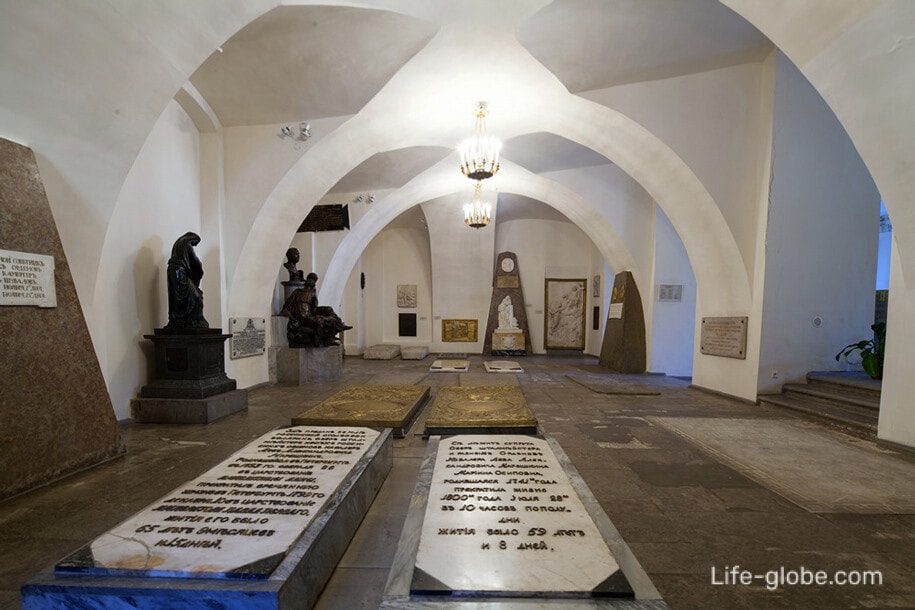
The spiritual building (bratsky) runs along the eastern line of the complex and connects the Annunciation Church with the Trinity Cathedral.
The construction of the building began in 1717 in accordance with the project of the architect D. Trezzini.
In 1820 - 1822, the architect V. P. Petrov rebuilt part of the Spiritual Building, arranging in such a new monastic church of the Descent of the Holy Spirit.
Subsequently, construction work continued, including the creation of greenhouses.
Today, the column hall of the Dukhovsky Building houses the Spiritual and Educational Center of the Alexander Nevsky Lavra.
The concert hall of the Alexander Nevsky Lavra hosts evenings dedicated to Russian traditional and modern Orthodox culture.

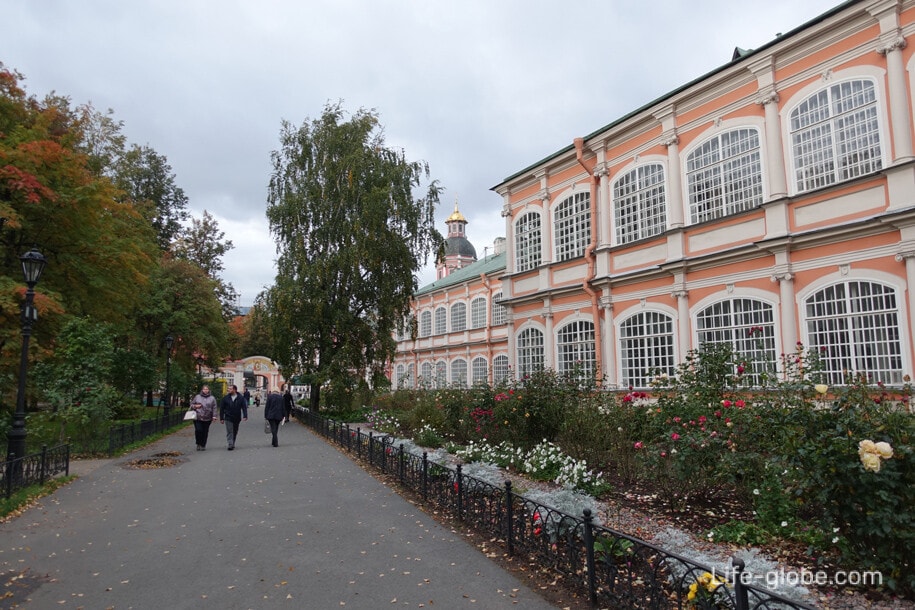
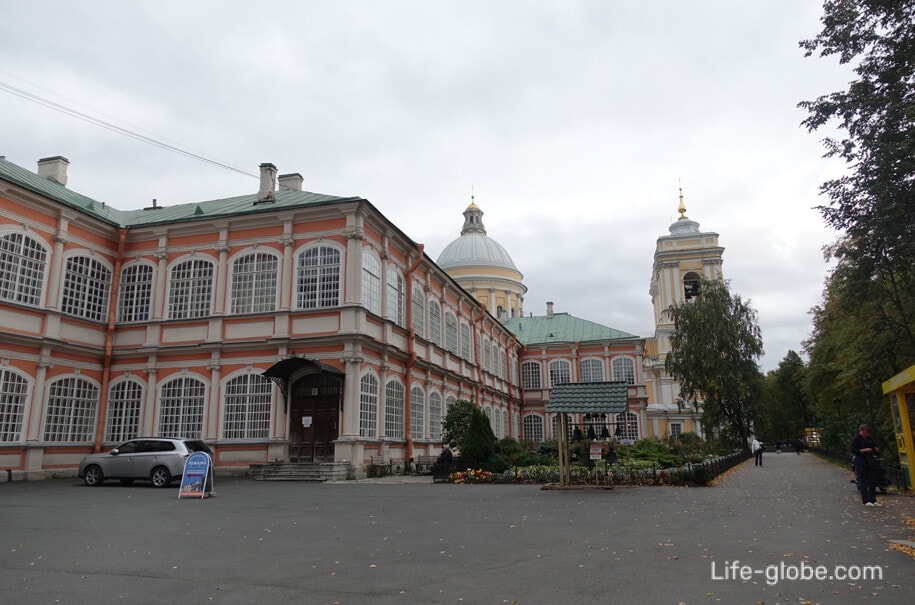
The building of the consistory and cemetery office was built in 1900 by the architect L. P. Andreev.
The building is part of the ensemble of the north-eastern part of the Lavra and has preserved the style of "Peter's (or Russian) Baroque".
The consistory was a church administrative body in the Russian Orthodox Church under the diocesan bishop (1774-1918). It was headed by a secretary appointed and subordinated to the Chief Prosecutor of the Synod.
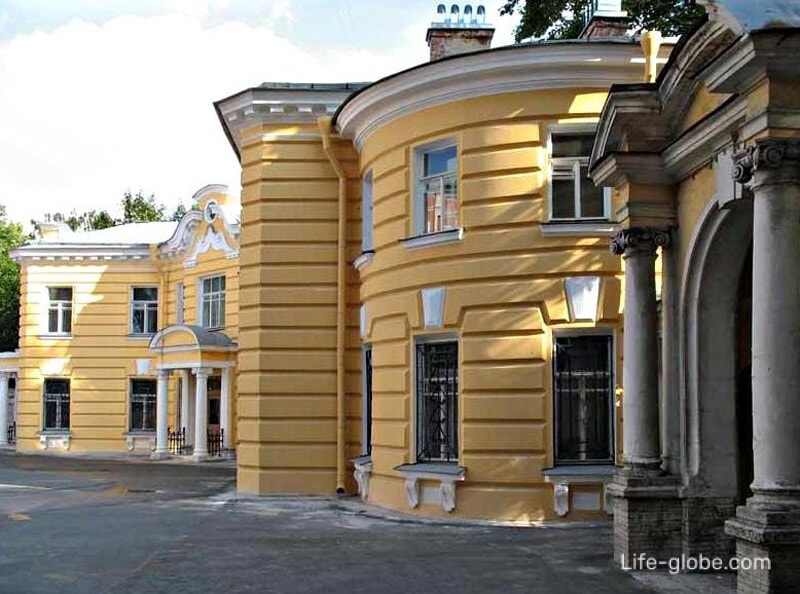
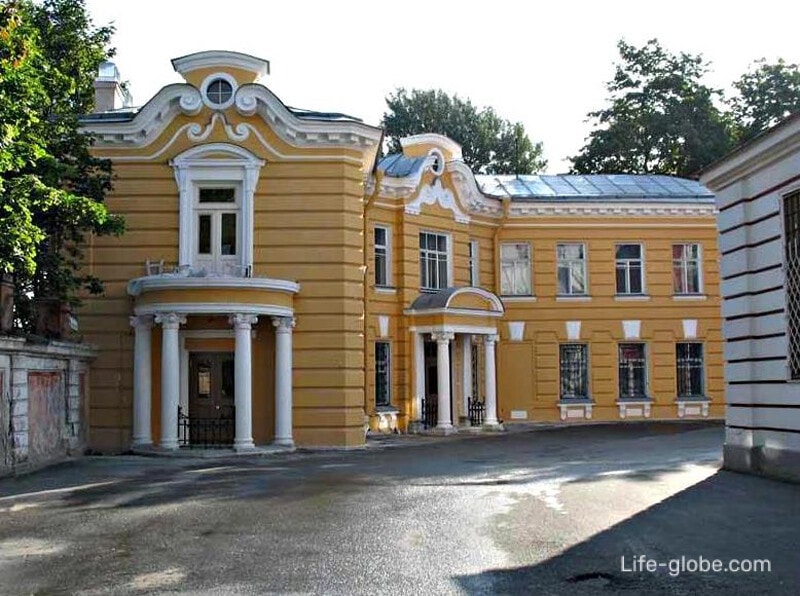
In front of the building, on the embankment of the Monastyrka River, there areConsistator gate, which has preserved the style characteristic of the Peter the Great Baroque.
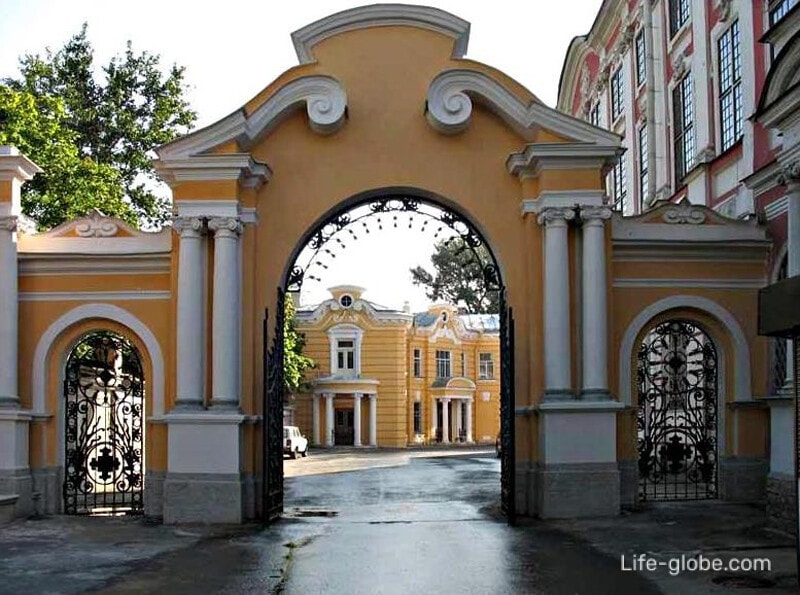
Since 1910, the library of the monastery, as well as the ancient repository with the archive, were placed in a specially built for this purpose, according to the project of the architect L. P. Shishko, the sacristy building, located next to the Dukhovsky Building and the eastern wall facing the Nikolskoye cemetery.
The building is one of the best examples of the style characteristic of St. Petersburg at the end of the 19th century and has a late eclectic style - it traces the use of elements of the so-called "historical" architectural styles: Neo-Renaissance, Neo-Baroque, Neo-Rococo, Neo-Byzantine style and pseudo-Russian style.
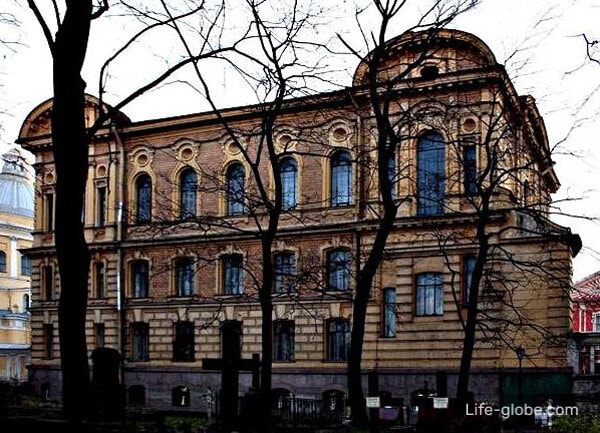
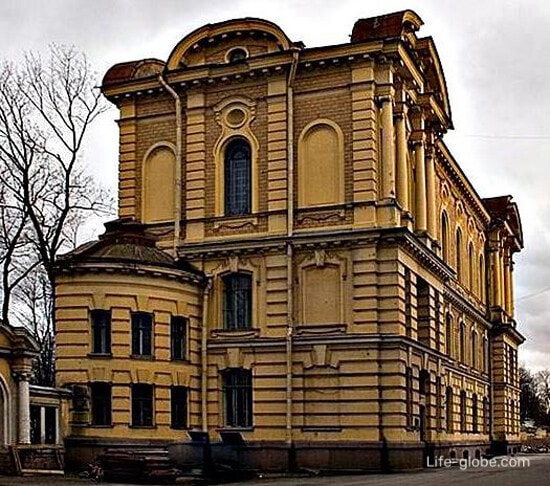
Alexander Nevsky Lavra Museum
The Museum of the Alexander Nevsky Lavra, opened in December 2013 (in the year of the 300th anniversary of the monastery), is located in the historical room of the sacristy.
The museum's exposition presents a collection of church antiquities, including: iconography and religious paintings, church vestments and liturgical items, decorative and applied art, historical documents and photographs.

The gate Church in the name of the Icon of the Mother of God "Joy of All Who Mourn" is the main entrance (entrance) to the Alexander Nevsky Lavra.
It is located on the side of Alexander Nevsky Square (the end of Nevsky Prospekt) and it is through these arched gates of the gate church that most of the guests of the Lavra pass.
The project of the gate church (the main entrance) was developed in 1783 by the architect I. E. Starov.
The construction of the church was carried out under the supervision of the architect M. E. Melentyev from 1784 to 1785; finishing work - from the autumn of 1785 to the spring of 1786.
The church was consecrated on July 15, 1786.
From the gate church in both directions departs stone semicircular fences, which emphasize the boundaries of the monastery territory.
View of the gate church and the monument to Alexander Nevsky (foreground) from Alexander Nevsky Square. Learn more about Alexander Nevsky Square and the monument...
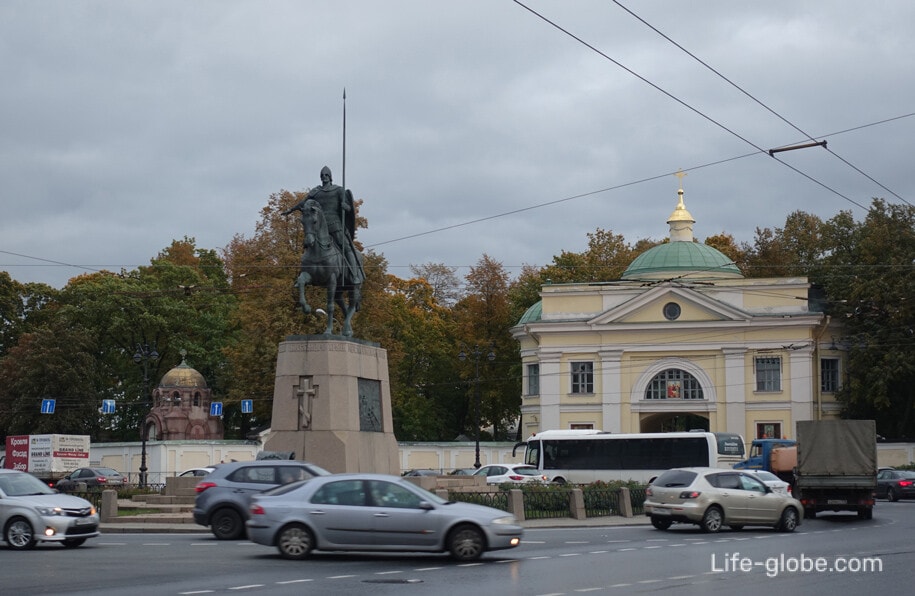
Interior of the gatehouse church
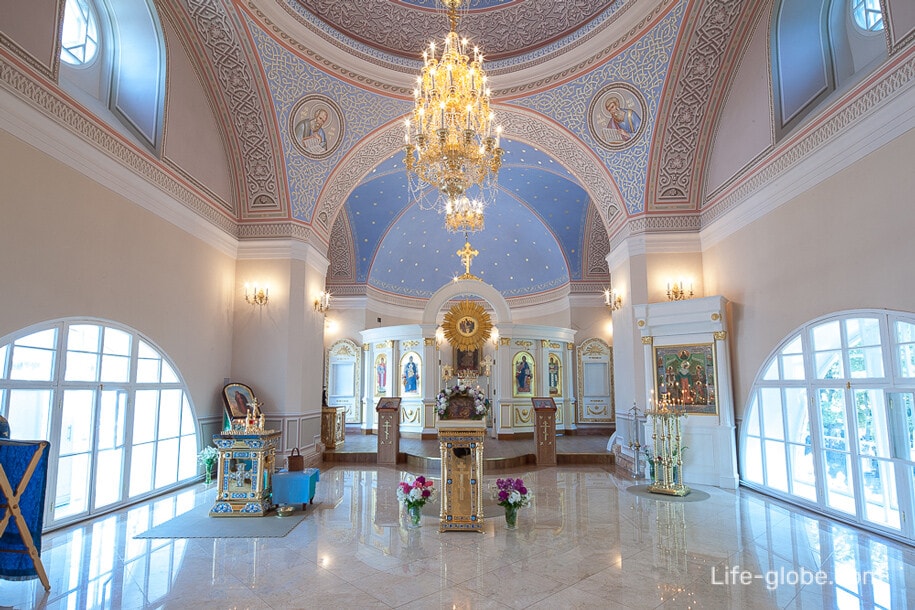

A road leads from the gate church to the central part of the monastery complex, on both sides of which, behind stone monumental fences, there are cemeteries (necropolises): Lazarevskoye and Tikhvinskoye.
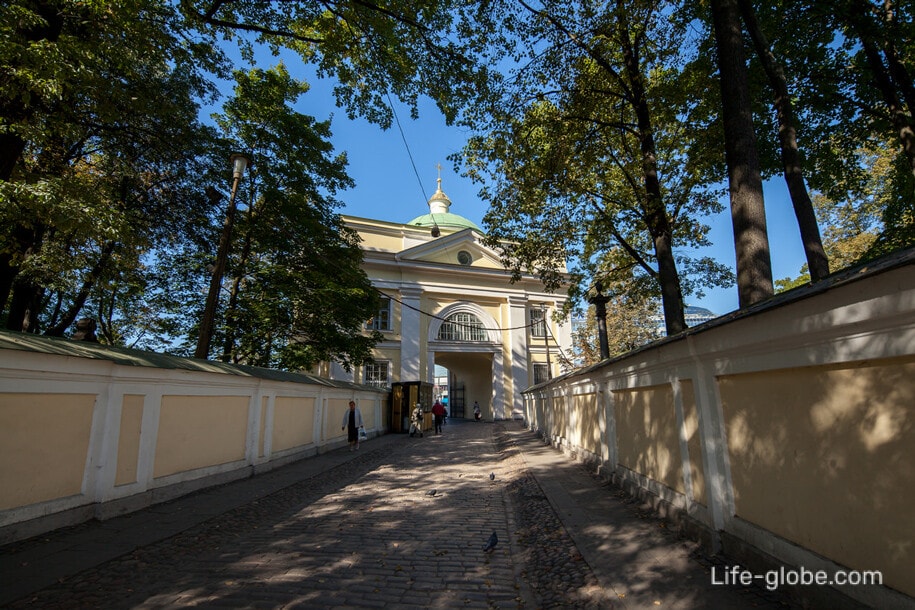
Lazarevskoye cemetery is located on the north (left) side of the road.
This cemetery is considered the oldest in St. Petersburg. It was founded simultaneously with the buildings of the Alexander Nevsky Monastery and served as a burial place for representatives of the privileged strata of St. Petersburg society.
Initially, the burials were held near the small wooden Church of the Annunciation, built in 1713 (rebuilt in the 1750s, dismantled in 1789) and in the Lazarevskaya tomb, where the name of the cemetery came from. Lazarevskaya tomb (Church of the Righteous Lazarus) - a small stone church ("tent"), built in 1717.
Initially, the burial in the cemetery required the personal permission of Peter I. The most honorable areas were considered near the Lazarevskaya tomb, built over the grave of the emperor's sister - Natalia Alekseevna. By the end of the century, it was allowed to bury people of the merchant class here, provided that an extremely large amount was paid.
From the first years of its foundation, the cemetery began to fill with highly artistic tombstones and monuments. At the beginning of the 20th century, plaster casts were made from some of them, which are now stored in The State Russian Museum and the Museum of the Russian Academy of Arts.
Since 1932, the cemetery has been an 18th-century necropolis museum and is part of the State Museum of Urban Sculpture. Tombstones of works by I. P. Martos, M. I. Kozlovsky, V. I. Demut-Malinovsky, Voronikhin, F. P. Tolstoy, as well as F. G. Gordeev, F. I. Shubin, I. P. Prokofiev, M. G. Krylov and other masters of Russian plastic art have been preserved.
Entrance to the necropolis museum is paid.
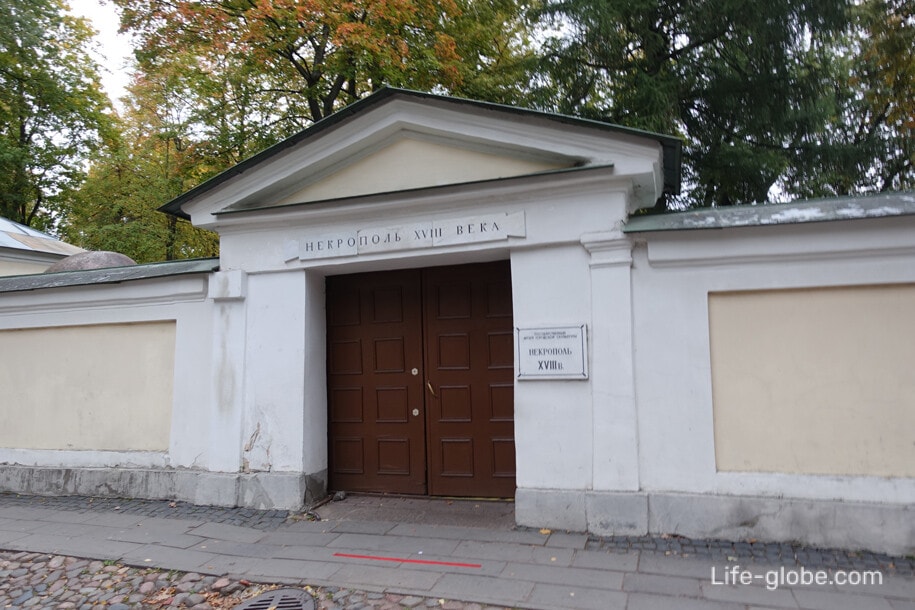
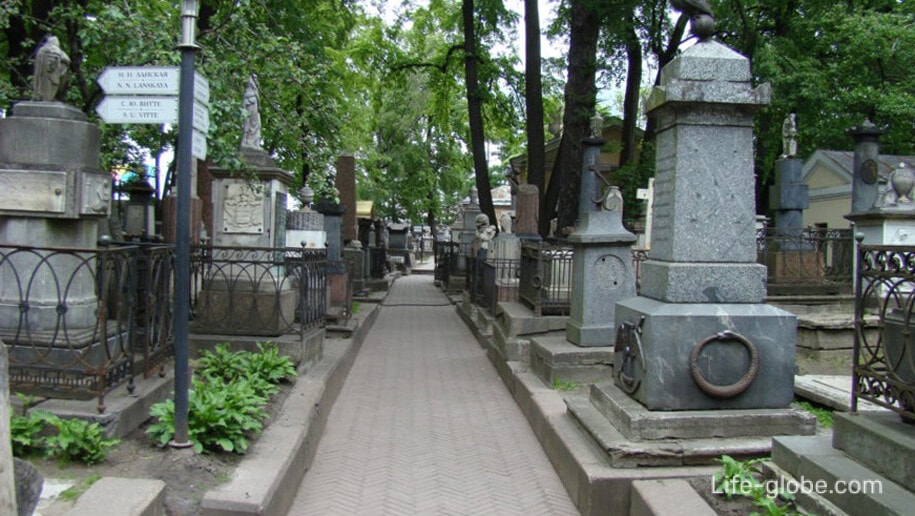

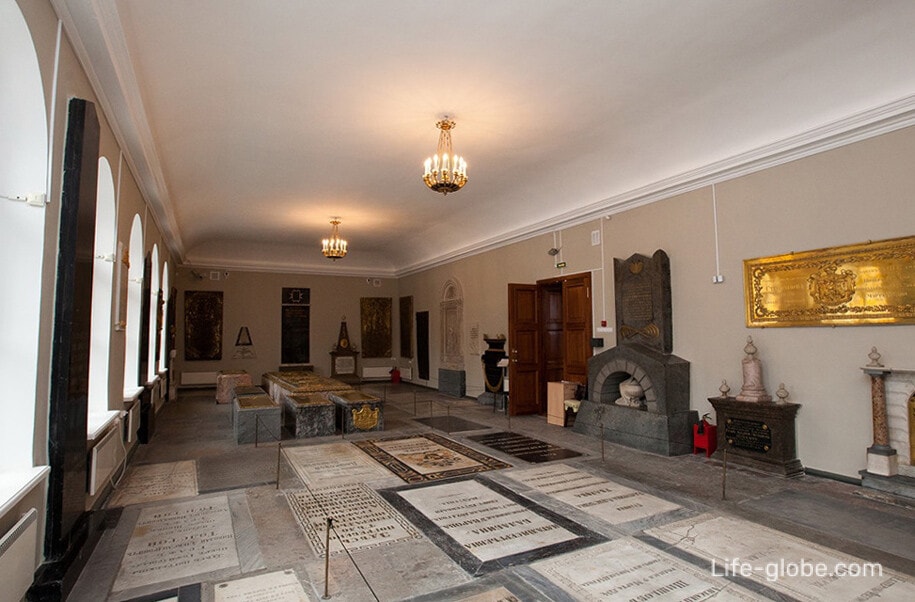
Tikhvin cemetery is located on the south (right) the sides of the road.
Due to the tightness of the Lazarevsky cemetery, since 1823, a new burial place was founded next to it (opposite), which began to be called Novo-Lazarevsky.
In 1869, according to the project of the architect N. P. Grebenka, a church-tomb in the name of the miraculous icon of the Tikhvin Mother of God was built within the cemetery. The temple was one-story, with a massive hipped roof topped with a crown.
According to the plan of 1881, the Tikhvin cemetery (as it became known from 1876) already occupied the modern borders, and was surrounded by stone fences.
Now the Tikhvin cemetery is a necropolis of the 19th century (the Necropolis of the Masters of Art) and, like the neighboring Lazarevskoye Cemetery, is part of the State Museum of Urban Sculpture. Buried in the cemetery are: N. M. Karamzin, I. A. Krylov, V. A. Zhukovsky, F. M. Dostoevsky, M. I. Glinka, M. P. Mussorgsky, N. A. Rimsky-Korsakov, P. I. Tchaikovsky, A. A. Ivanov, B. M. Kustodiev, V. I. Demut-Malinovsky, B. I. Orlovsky, P. K. Klodt, V. P. Stasov, V. F. Komissarzhevskaya and N. K. Cherkasov.
Entrance to the necropolis museum is paid.
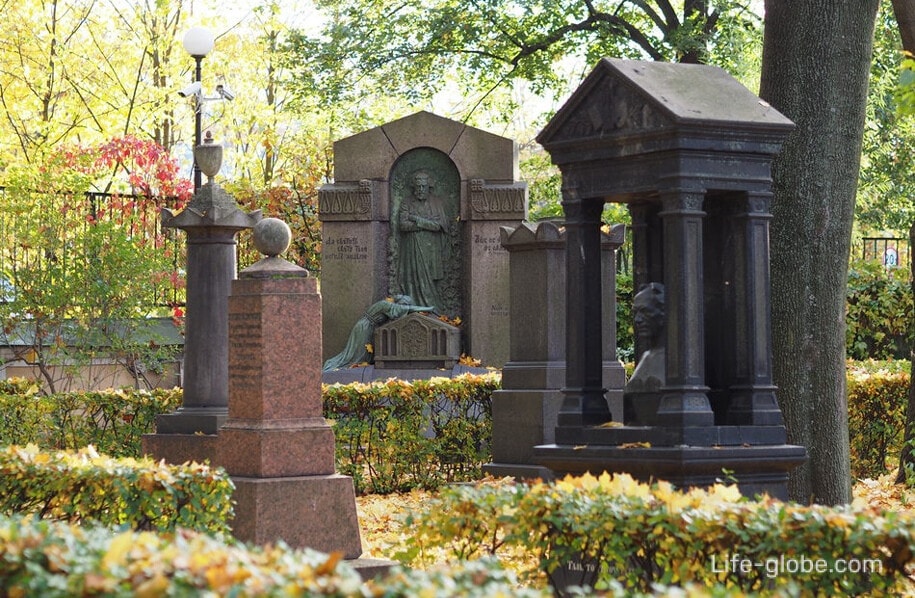
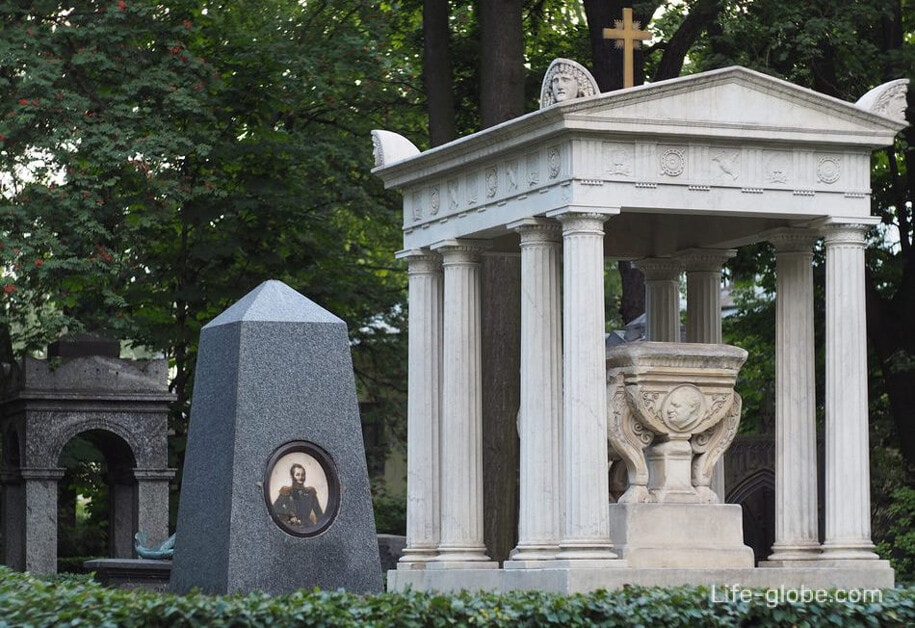
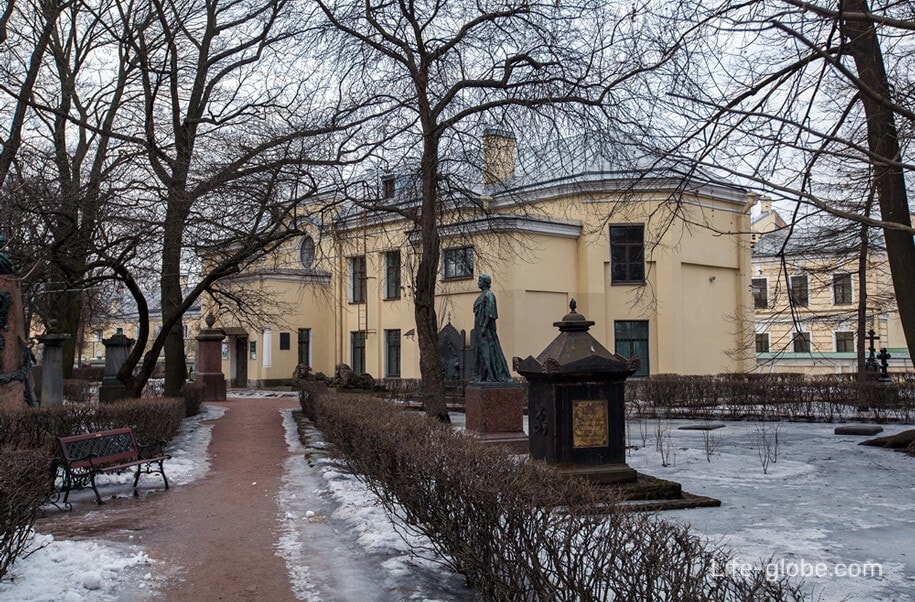
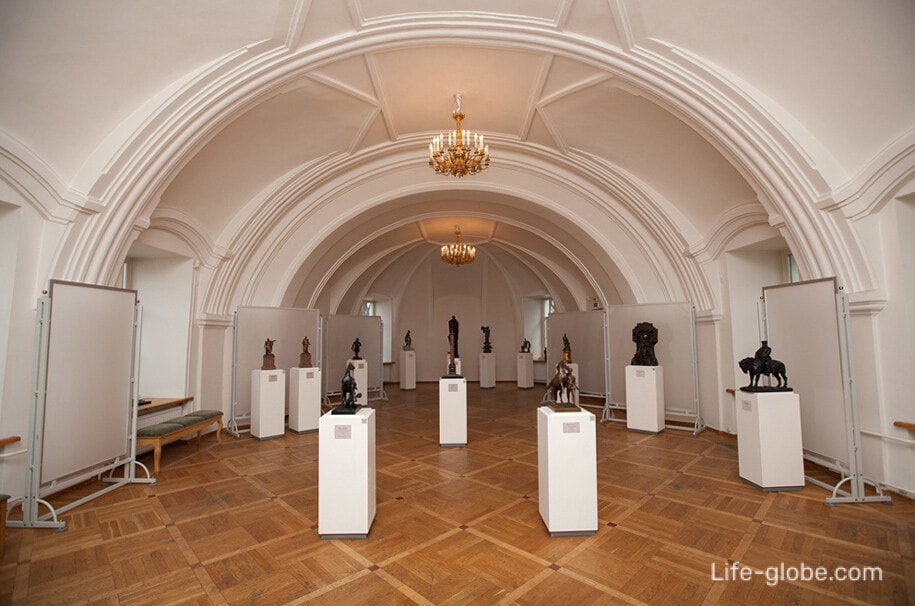
!!! The ticket office of the museum in the necropolis (cemetery) is located at the entrance to the Necropolis of the Masters of Arts (Tikhvin Cemetery). You can buy a separate ticket to any of the necropolises or a general ticket to the Necropolis of the 18th century and the Necropolis of the Masters of Art.
In 1861, due to the lack of places in other cemeteries of the Lavra, it was decided to allocate a place for burial between the Neva River and the eastern fence of the monastery.
The regular plan of the cemetery, divided into categories, was drawn up by the diocesan architect G. I. Karpov. Since 1868, the cemetery was called Zasoborny, and in 1877 it was named Nikolsky-after the Church of St. Nicholas the Wonderworker, built within the cemetery in 1868-1871 by the project of G. I. Karpov at the expense of the merchant N. I. Rusanov.
Among those buried at the Nikolsky cemetery: writers and artists, military figures, journalists and scientists. At the beginning of the 20th century, the first Russian aviators were buried in the cemetery: S. I. Utochkin, L. M. Matsievich and V. M. Abramovich.
Today, the cemetery has many graves related to the history of the St. Petersburg diocese and the Russian Orthodox Church as a whole. The chapel-crypt, where St. Petersburg recluse Blessed Matthew Tatomir was buried in 1904, is particularly revered.
The north-western section of the cemetery, the so-called Bratskaya site, since the end of the 19th century served for the burial of the inhabitants of the Lavra and the St. Petersburg metropolitans.
In 1932, the St. Nicholas Church and cemetery were closed. In the mid-1930s, some burials were moved to museum necropolises, but the systematic destruction of monuments for the purpose of extracting polished stone led to the loss of hundreds of burials.
In the 1980s, the building of St. Nicholas Church was handed over to the faithful, then restored and consecrated in 1985. In the mid-1980s, the relics of St. Matthew were transferred to the altar of the St. Nicholas Cemetery Church.
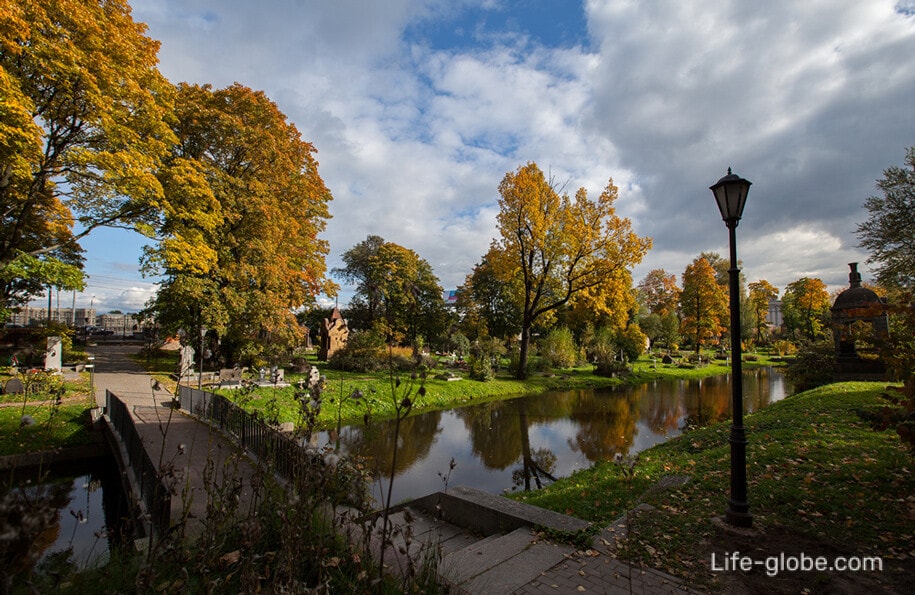
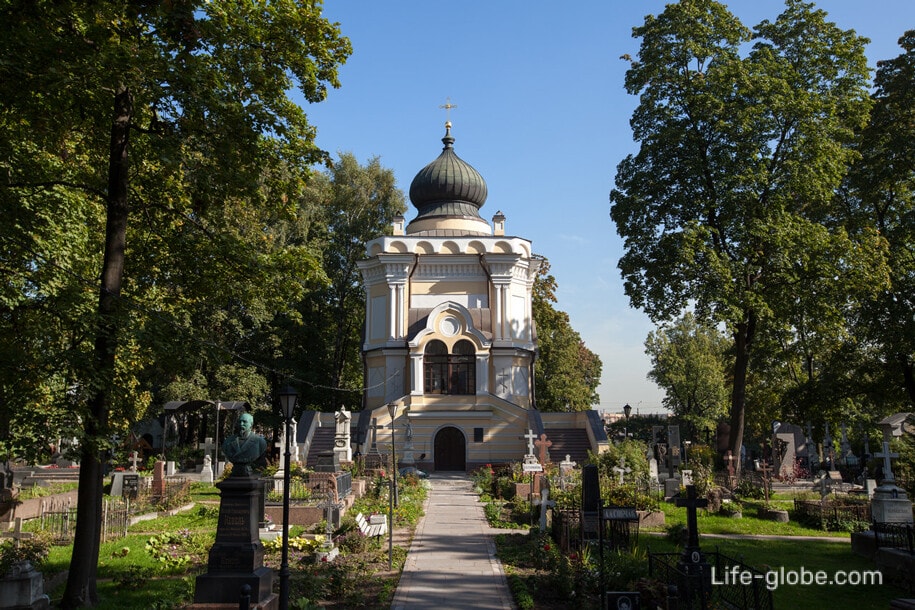
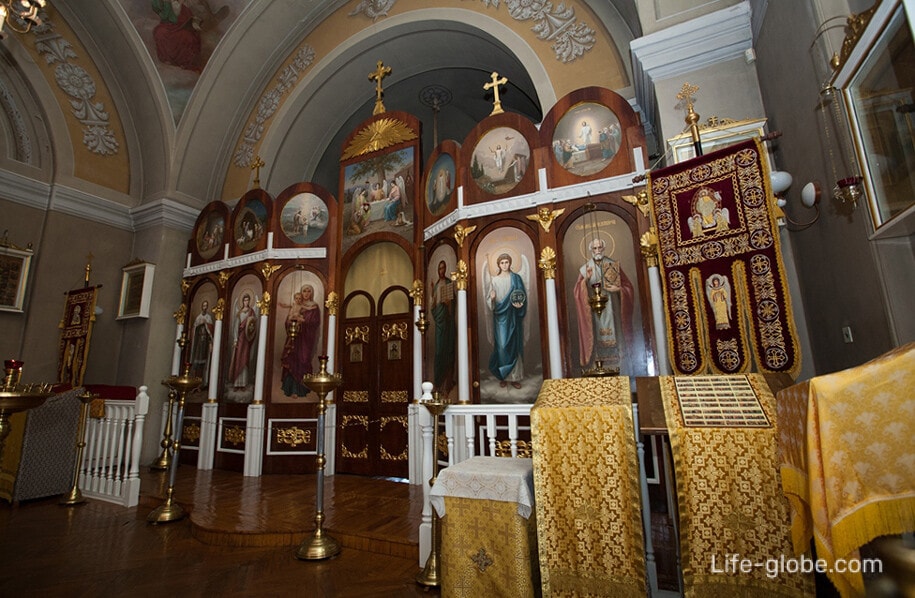
The first concern for the establishment of an almshouse in St. Petersburg belongs to the Tsarevna Natalia Alekseevna, who in 1713, near the present Tavrichesky Garden, established an almshouse for poor old women.
An almshouse (from the words of God of deeds, that is, for God) is a god-pleasing institution for the care of persons who are unable to work: the elderly, the infirm, the crippled, and the convalescent (but not the temporarily sick and insane, for whom there are special institutions).
An essential feature of the almshouse was the full content given to the prizrevaemye. Like all charitable institutions, almshouses appeared together with Christianity and were originally arranged at hospitals and even merged with them.
The small building of the former Lavra almshouse is inscribed in a stone fence and overlooks the current Alexander Nevsky Square.
The building is designed in the style of strict classicism and harmoniously fits into the circle of the fence of the Alexander Nevsky Monastery, with which the architect I. E. Starov perfectly coped in 1783-1789.
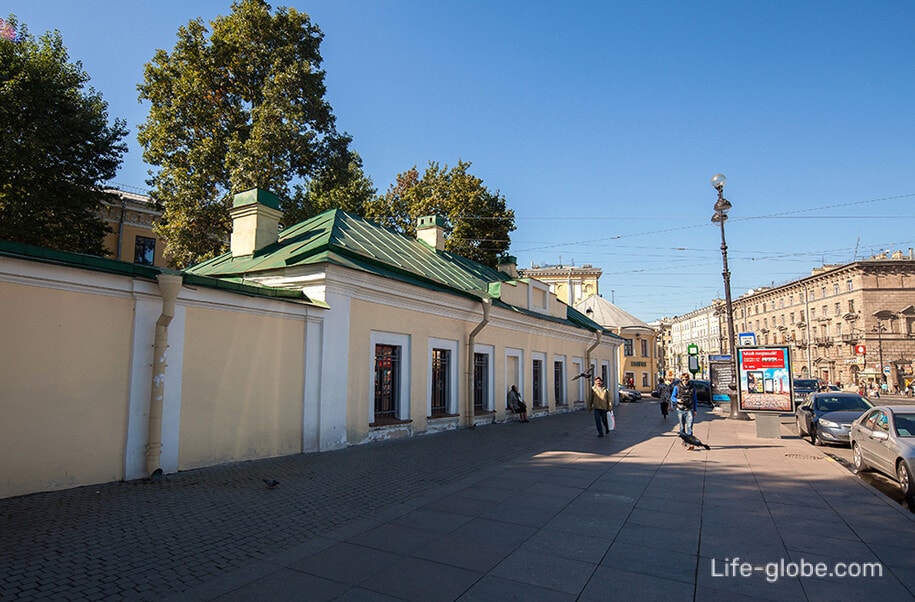
The complex of the Alexander Nevsky Lavra includes preserved former grain barns.
Several dozen stone barns were built in the mid-19th century near the north-eastern and south-eastern sides of the Lavra. Most of the barns were rented out to grain merchants for a fee of 1,100 rubles a year.
After the Great Patriotic War and during the construction of the Alexander Nevsky Bridge, most of the barns were demolished. Now only the barns along the embankment of the Obvodny Canal, 3, 5, 5a, 5b, 5b, have been preserved.
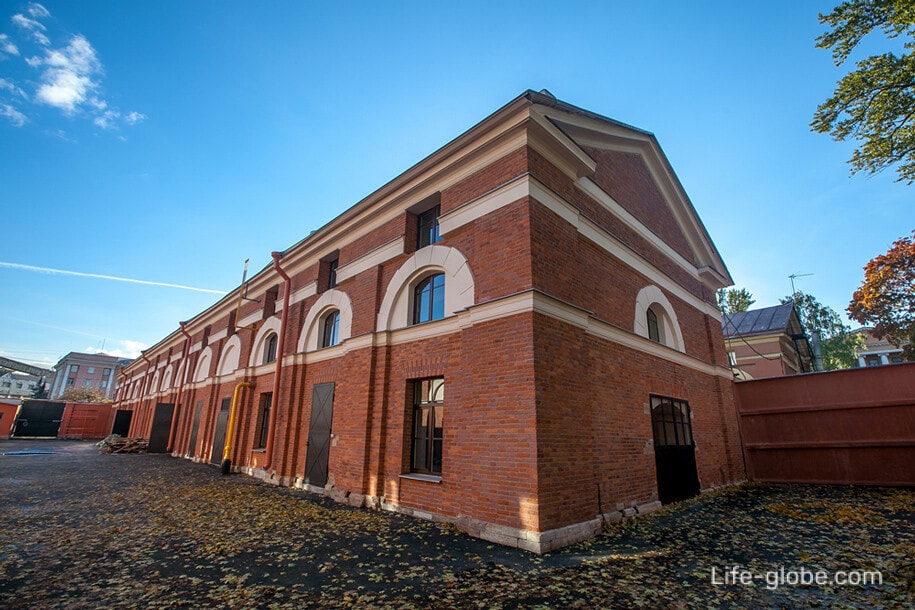
A stone kiosk with the Konev Icon of the Mother of God is located in the back yard of the Lavra.
The area near the kiosk is ennobled and is a place for pilgrims to relax-next to the kiosk there is a small garden with a decorative pond and two gazebos.
The two-meter image made of artificial marble was made in the Icon-painting and restoration Workshop of the monastery under the direction of the icon-restorer Dmitry Gennadyevich Mironenko.
The Kyot was consecrated on July 10, 2015.

The Lazarevskoye and Tikhvinskoye cemeteries, as well as the Lazarevskaya and Blagoveshchenskaya tombs of the Alexander Nevsky Lavra, are part of the State Museum of Urban Sculpture, which was founded in 1932.
Website of the State Museum of Urban Sculpture: gmgs.ru.
The complex of the Holy Trinity Alexander Nevsky Lavra also includes skeets and attached churches located outside the main ensemble of the monastery in St. Petersburg (described above).
Address of the Alexander Nevsky Lavra: embankment of the Monastyrka River, 1.
Coordinates of the Alexander Nevsky Lavra: 59°55'11"N 30°23'19"E (59.919722, 30.388611).
Website of the Alexander Nevsky Lavra: lavra.spb.
The nearest metrostations are: "Alexander Nevsky Square 2" and "Alexander Nevsky Square 1".
How to get to Lavra from the metro station "Alexander Nevsky Square 2"
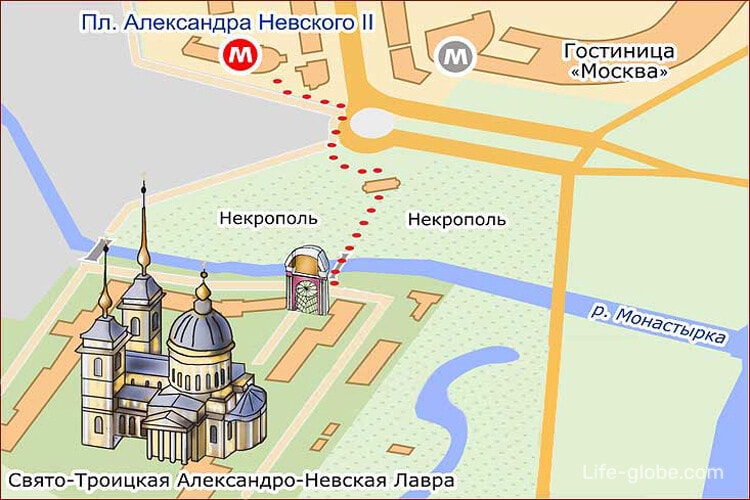
You can visit the Alexander Nevsky Lavra on your own or with one of the excursions in St. Petersburg
You can stop near the Alexander Nevsky Lavra
Offering rooms with river views, heating, free Wi-Fi and free parking, the Pilgrim's House Inn offers rooms with free Wi-Fi.
Rooms here will provide you with a wardrobe, a desk, a TV and a private bathroom. Link to the mini-hotel
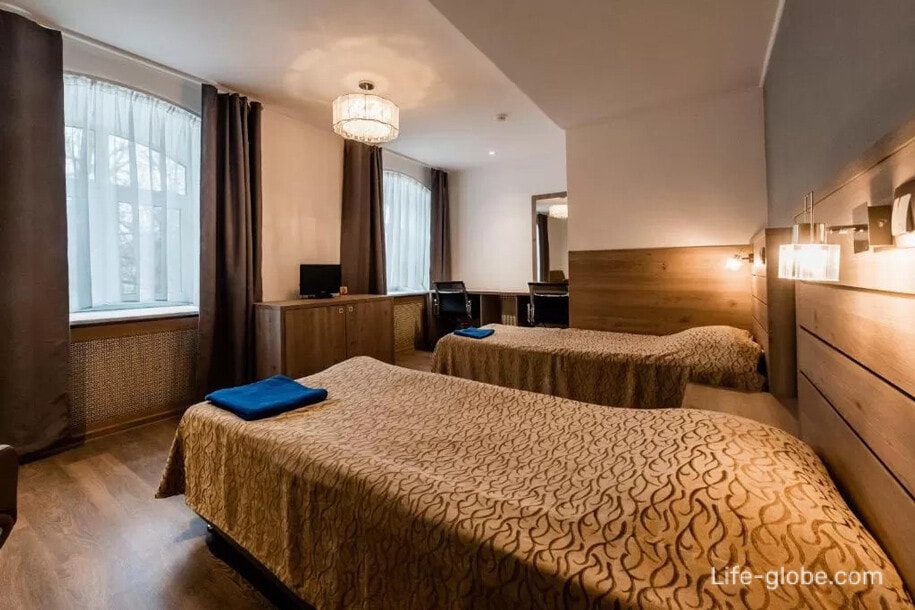
The 4-star Moscow Hotelis located on Alexander Nevsky Square.
Some rooms offer views of the Neva River and the Alexander Nevsky Lavra.
In the hotel: restaurants, including panoramic restaurant beef bar, free Wi-Fi, spa and wellness center, private Parking. On the floors there are coolers with hot and cold drinking water.
Each roomhere will provide you with a refrigerator, air conditioning, a free safety deposit box and free toiletries. Most rooms have an electric kettle.
Breakfast is included in the room rate. Link to the hotel
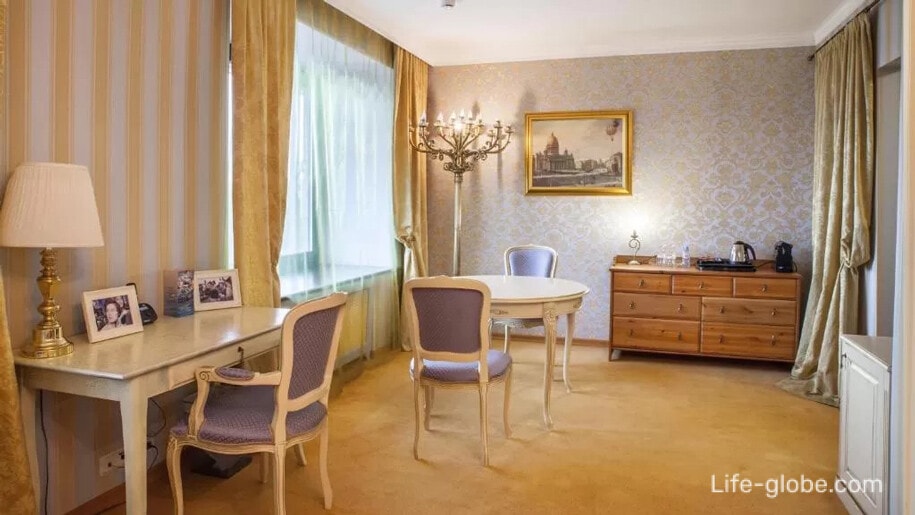
Offering a sauna, a shared lounge, a 24-hour front desk, free Wi-Fi, free private parking and room service, Genesis Hotel also offers rooms with free Wi-Fi.
The rooms are equipped with airconditioning, a kettle, a flat-screen TV with cable channels, and a private bathroom. Link to the hotel
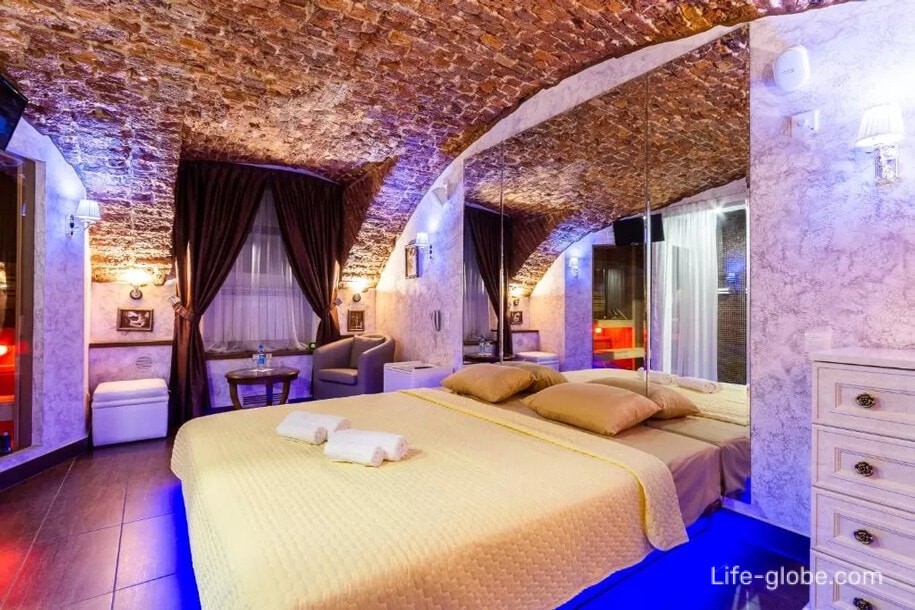
All accommodation facilities in St. Petersburg, including near the Lavra, as well as in the city center and more remote from it, can be viewed and booked here